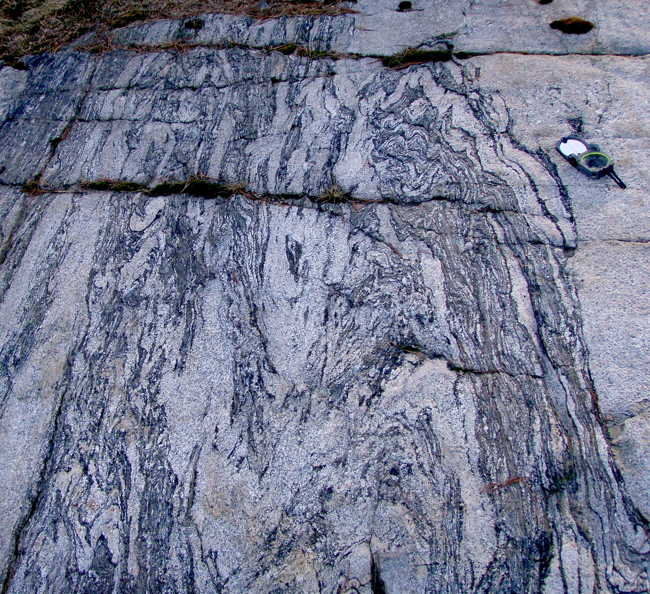This week’s Friday fold is courtesy of Joe Kopera, of the Massachusetts Geological Survey in Amherst. Joe is co-leading a field trip this summer with Yvette Kuiper (Colorado School of Mines) on the structural geology of this same area as part of the Structural Geology and Tectonics Forum. I’m planning on attending it, and am excited to see these rocks for myself. I’ll let Joe take it from here…
This fold is folding compositional and migmatitic layering in the (NeoProterozoic-to-Ordovician?) Nashoba Formation and sills of the associated (Silurian-earliest-Devonian?) Acton granite in eastern Massachusetts. The F2 fold folds an S1 migmatitic gneissosity and is cut to the left by axial planar, syn-to-post migmatitic shear bands (S1/S2 composite to S2, depending on the outcrop), all contemporaneous with migmatization. The folds are upright with subhorizontal to gently plunging (<30°) axes… again, depends on the outcrop… some of the folds are definitely non-cylindrical, but, regionally, I still have to figure out what’s going on with them. The shear bands are vertical and have yet to yield consistent shear sense indicators.

(click on image for full-size view)
To the right, it’s cut by / interacting with a sill of the Acton granite. The Nashoba formation itself is a lithodemic assemblage of upper amphibolite-grade (sill-kspar) migmatitic biotite gneisses, locally containing boatloads of magnetite, locally pelitic, interlayered with psammites, amphibolites, rusty-sulfidic schists, metavolcanic, quartzites, and marbles. It’s generally interpreted as being arc-related sediments. Currently, the regional-thinkers are lumping it with the Gander terrane, but it’s not based on much actual evidence from the terrane itself.
Field relations show the intrusion of the Acton granite to be generally syntectonic (with some caveats), although it’s still conjecture if the granite is a large body of neosomal (neosomic?) melt or is legitimately plutonic.
As for the age, migmatization and the bulk of deformation probably occurred ~425 Ma during the Salinic / early Acadian orogeny, based on a single nearby metamorphic monazite age by Chris Hepburn, also with a bunch of caveats. There are later structures, not shown in the photo, but to be visited on the fieldtrip, that are lower-grade and presumably related to the Alleghenian orogeny.
Suffice to say, the whole belt of rocks needs a ton of more detailed structural, petrologic, and gechronologic work before we can really say anything with confidence about it. As for when it docked to the Laurentian margin, one could easily argue for the Acadian (early Devonian up here) or the Alleghenian (Carboniferous to Permian up here) and have ample evidence to support either until more work is done.
Awesome! Can’t wait to visit in person. If readers haven’t yet signed up for the SG&T Forum yet, here’s the link to do so.
